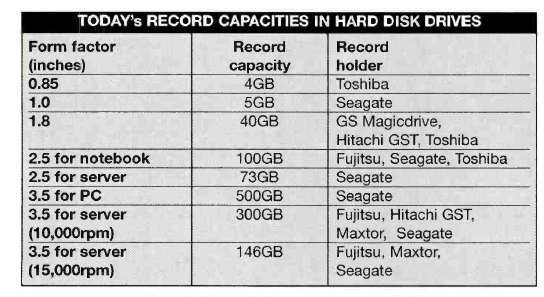History 2004: Seagate Sets Record with Half Terabyte on HDD
Surface density of 108Gb/in²
This is a Press Release edited by StorageNewsletter.com on April 25, 2024 at 2:00 pmThe capacity of disks has increased less rapidly for the past 2 years, since the physical limits of longitudinal magnetic recording have been nearly attained.
But the few manufacturers that remain, roughly ten or so, have no choice but to go just a little further than their rivals, in order to scrounge for that extra crumb of market share.
The ≠1 company in the field, Seagate Technology, has made what is undoubtedly the most important announcement in the history of the HDD industry, with the simultaneous launch on June 14 of 8 new product lines (see tables below), renewing nearly its entire portfolio, now the largest in the industry, along with that of Hitachi GST (which combines former Hitachi and IBM lines).
Seagate’s most impressive announcement by far was the 3.5-inch form factor NL35, its 500GB or half-terabyte unit, a capacity record for any category of drive, on 4 stacked platters of 125GB each, thus besting Hitachi GST’s 400GB on 5x80GB platters. The record-breaking drive boasts a surface density of 108Gb/in², another first.
To give some indication of the capacity, a half terabyte can holed some 400 hours of standard television content, or 44 hours of HDTV. Something one could save for a rainy day…
Another record for the HOD maker: 5GB in the one-inch form factor here again at 108Gb/in2-in which Seagate is making a strong debut, preferring not to venture at all into 1.8-inch devices, and leaving Toshiba alone with 0.85-inch drives.
For the rest of the products, the company is keeping pace with its competitors’ product releases, with a 100GB 2.5-inch notebook unit and 2 drives for servers, the first with up to 300GB in its 10,000rpm line and up to 146GB at 15,000rpm.
No prices for any of the new devices were mentioned. We can expect a full terabyte on a HDD within roughly a year and a half.
Rob Pait, director of consumer electronics marketing at Seagate, indicates that in 2 years, there will be a terabyte drive for less than $200 (0.20 cents per gigabyte), a 200GB notebook unit for less than $150 and a one-inch 10GB device for less than $100.
Beyond that, companies will hit the superparamagnetic limit. The industry will then have to switch from longitudinal to perpendicular recording, on which many of the manufacturers have been working night and day.

This article is an abstract of news published on issue 198 on July 2004 from the former paper version of Computer Data Storage Newsletter.














 Subscribe to our free daily newsletter
Subscribe to our free daily newsletter

